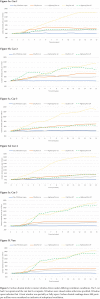SARS in Cars: Carbon Dioxide Levels Provide a Simple Means to Assess Ventilation in Motor Vehicles
- PMID: 35178491
- PMCID: PMC8843085
- DOI: 10.20411/pai.v7i1.493
SARS in Cars: Carbon Dioxide Levels Provide a Simple Means to Assess Ventilation in Motor Vehicles
Abstract
Background: Poorly ventilated enclosed spaces pose a risk for airborne transmission of severe acute respiratory syndrome coronavirus 2 (SARS-CoV-2) and other respiratory viruses. Limited information is available on ventilation in motor vehicles under differing driving conditions.
Methods: We conducted carbon dioxide measurements to assess ventilation in motor vehicles under varying driving conditions with 2 to 3 vehicle occupants. During routine driving, carbon dioxide produced by the breathing of vehicle occupants was measured inside 5 cars and a van under a variety of driving conditions with or without the ventilation fan on and with windows open or closed. Carbon dioxide readings above 800 parts per million (ppm) were considered an indicator of suboptimal ventilation.
Results: Carbon dioxide levels remained below 800 ppm in all vehicles if the ventilation fan was on and/or the windows were open while parked or during city or highway driving. With the ventilation system set on non-recirculation mode, carbon dioxide levels rose above 800 ppm in all vehicles when the fan was off and the windows were closed while parked and during city driving, and in 2 of the 6 vehicles during highway driving. With the ventilation system set on recirculation mode, carbon dioxide rose above 800 ppm within 10 minutes in all vehicles tested.
Conclusion: Carbon dioxide measurements could provide a practical and rapid method to assess ventilation in motor vehicles. Simple measures such as opening windows, turning on the fan, and avoiding the recirculation mode greatly improve ventilation.
Keywords: COVID-19; SARS-CoV-2; Ventilation; aerosol; carbon dioxide; transmission.
Copyright © 2022 Pathogens and Immunity.
Conflict of interest statement
C.J.D has received research grants from Clorox, Pfizer, and PDI. All other authors report no conflicts of interest relevant to this article.
Figures




References
-
- Jones LD, Chan ER, Zabarsky TF, Cadnum JL, Navas ME, Redmond SN, Kovach JD, Linger M, Rutala WA, Zimmerman PA, Donskey CJ. Transmission of SARS-CoV-2 on a Patient Transport Van. Clin Infect Dis. 2021. doi: 10.1093/cid/ciab347. PubMed PMID: 33893474; PMCID: PMC8135457. - DOI - PMC - PubMed
-
- Prevention CfDCa. Domestic Travel During COVID-19 Information for People Traveling within the United States and U.S. Territories 2022 [cited 2022 January 4]. Available from: https://www.cdc.gov/coronavirus/2019-ncov/travelers/travel-during-covid1....
-
- Shen Y, Li C, Dong H, Wang Z, Martinez L, Sun Z, Handel A, Chen Z, Chen E, Ebell MH, Wang F, Yi B, Wang H, Wang X, Wang A, Chen B, Qi Y, Liang L, Li Y, Ling F, Chen J, Xu G. Community Outbreak Investigation of SARS-CoV-2 Transmission Among Bus Riders in Eastern China. JAMA Intern Med. 2020;180(12):1665–71. doi: 10.1001/jamainternmed.2020.5225. PubMed PMID: 32870239; PMCID: PMC7489377. - DOI - PMC - PubMed
LinkOut - more resources
Full Text Sources
Miscellaneous
